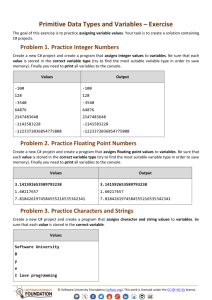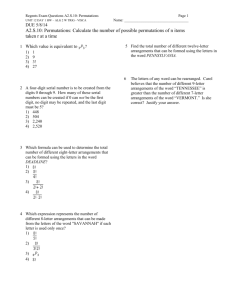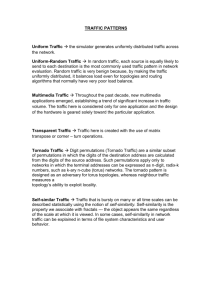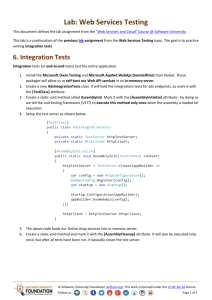Algortihms
advertisement
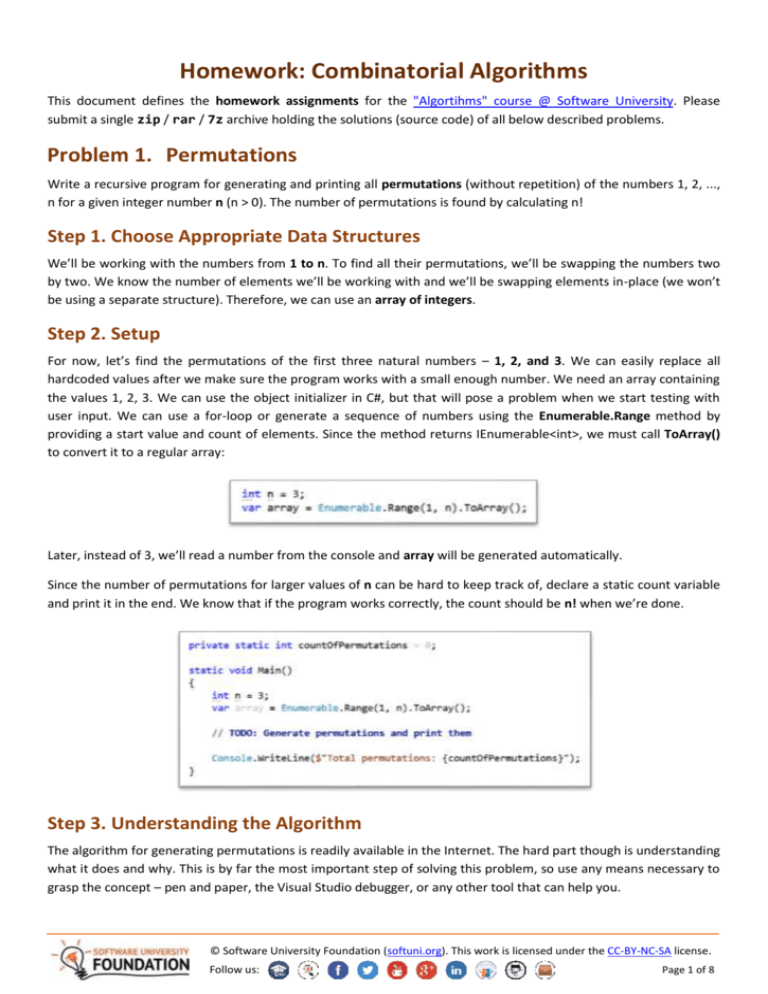
Homework: Combinatorial Algorithms
This document defines the homework assignments for the "Algortihms" course @ Software University. Please
submit a single zip / rar / 7z archive holding the solutions (source code) of all below described problems.
Problem 1. Permutations
Write a recursive program for generating and printing all permutations (without repetition) of the numbers 1, 2, ...,
n for a given integer number n (n > 0). The number of permutations is found by calculating n!
Step 1. Choose Appropriate Data Structures
We’ll be working with the numbers from 1 to n. To find all their permutations, we’ll be swapping the numbers two
by two. We know the number of elements we’ll be working with and we’ll be swapping elements in-place (we won’t
be using a separate structure). Therefore, we can use an array of integers.
Step 2. Setup
For now, let’s find the permutations of the first three natural numbers – 1, 2, and 3. We can easily replace all
hardcoded values after we make sure the program works with a small enough number. We need an array containing
the values 1, 2, 3. We can use the object initializer in C#, but that will pose a problem when we start testing with
user input. We can use a for-loop or generate a sequence of numbers using the Enumerable.Range method by
providing a start value and count of elements. Since the method returns IEnumerable<int>, we must call ToArray()
to convert it to a regular array:
Later, instead of 3, we’ll read a number from the console and array will be generated automatically.
Since the number of permutations for larger values of n can be hard to keep track of, declare a static count variable
and print it in the end. We know that if the program works correctly, the count should be n! when we’re done.
Step 3. Understanding the Algorithm
The algorithm for generating permutations is readily available in the Internet. The hard part though is understanding
what it does and why. This is by far the most important step of solving this problem, so use any means necessary to
grasp the concept – pen and paper, the Visual Studio debugger, or any other tool that can help you.
© Software University Foundation (softuni.org). This work is licensed under the CC-BY-NC-SA license.
Follow us:
Page 1 of 8
The algorithm works like this:
1. Start at a given index i in the array
2. For each index k (starting with i), swap the two numbers at indices i and k and continue permuting from i + 1
(this is the recursive call)
3. Stop the process when you reach the last element and print the array.
In essence, to find all permutations of the numbers 1, 2 and 3, we do the following steps:
Loop from 1 to 3
At each step, we have a different number at index 0
o When at index 0 we have 1, we obtain all permutations starting with 1 by calling the Permute
method for the rest of the numbers (indices 1 to n – 1). This will produce the permutations [1, 2, 3]
and [1, 3, 2]
o We swap 1 and 2, now 2 is at index 0. Again, we continue by finding all permutations of the numbers
from index 1 to index n – 1. This will produce the permutations [2, 1, 3] and [2, 3, 1]. Before we
continue, we swap back 1 and 2
o We swap 1 and 3, now 3 is at index 0. We find all permutations starting with 3 by generating the
permutations of the other two numbers, so we obtain [3, 2, 1] and [3, 1, 2].
In short, we try each number at the first position and generate recursively all permutations of the rest of the
numbers.
Go through the steps with pen and paper; with 3 elements it is manageable to keep track of each step and if you
understand the process in principle, you’ll be able to solve the problem with larger values for n.
Step 4. Coding the Solution
Go through the steps above until you understand how the program should work. When you know what needs to be
done, coding the solution is the easier task.
We’ll need a method which permutes the numbers starting from a given index. It should work on the array, so we
can declare it as follows:
The easiest part is the bottom of the recursion. When start index is the last index, print the array and increment the
count variable:
Now, in the else clause we need to loop through all elements and swap each of them with the element at the
startIndex:
© Software University Foundation (softuni.org). This work is licensed under the CC-BY-NC-SA license.
Follow us:
Page 2 of 8
Swapping two integer numbers can be done in several ways. Create a Swap method and use an implementation of
your choice. Here is one using the XOR operator to swap two variable values without the use of a temporary
variable:
So, we need to call Swap, then find all permutations from i + 1 and swap back the two elements by calling Swap
again with the same numbers like this:
Complete the TODOs and test. This should be the result:
© Software University Foundation (softuni.org). This work is licensed under the CC-BY-NC-SA license.
Follow us:
Page 3 of 8
Step 5. Remove Hardcoded Values and Retest
Finally, just modify the Main method to receive n from the console:
Test with several different values. With n > 4 it will be hard to manually check if all permutations obtained are
correct, but you can at least make sure they are as many as they should be – n!
Examples:
Input Output
n=3
1, 2,
1, 3,
2, 1,
2, 3,
3, 2,
3, 1,
Total
3
2
3
1
1
2
permutations: 6
n=5
1, 2,
1, 2,
1, 2,
1, 2,
1, 2,
1, 2,
1, 3,
1, 3,
1, 3,
1, 3,
…
5, 1,
5, 1,
Total
3,
3,
4,
4,
5,
5,
2,
2,
4,
4,
4,
5,
3,
5,
4,
3,
4,
5,
2,
5,
5
4
5
3
3
4
5
4
5
2
2, 4, 3
2, 3, 4
permutations: 120
© Software University Foundation (softuni.org). This work is licensed under the CC-BY-NC-SA license.
Follow us:
Page 4 of 8
Problem 2. Generate Permutations Iteratively
The above problem presented a recursive solution for generating all permutations (without repeating elements) of a
collection. Your task is to write a non-recursive algorithm to achieve the same goal. There shouldn’t be any
recursive calls in your program (only loops). You may use the examples for problem 1 to check whether your
solution is correct.
Hint: http://www.quickperm.org/
Problem 3. Generate Combinations Iteratively
Write an iterative program to generate all combinations (without repetition) of k elements from a set of n elements.
Remember, in combinations, the order of elements doesn’t matter – (1 2) and (2 1) are considered the same
combination. You are not allowed to use recursion. Search the Internet for a suitable algorithm.
Input Output
n=3
k=2
1 2
1 3
2 3
n=5
k=3
1
1
1
1
1
1
2
2
2
3
2
2
2
3
3
4
3
3
4
4
3
4
5
4
5
5
4
5
5
5
Problem 4. Generate Subsets of String Array
Write a recursive program for generating and printing all subsets of k strings from given set of strings s.
Input
Output
Solution with nested loops
var set = new[] { "test", "rock", "fun" };
int k = 2;
s = {test, rock, fun}
k = 2
(test rock) for (int i1 = 0; i1 < set.Length; i1++)
{
(test fun)
for (int i2 = i1 + 1; i2 < set.Length; i2++)
(rock fun)
{
Console.WriteLine($"({set[i1]} {set[i2]})");
}
}
Problem 5. Permutations with Repetition
Write a program to generate all permutations with repetition of a given multi-set. Ensure your program efficiently
avoids duplicated permutations. Test it with { 1, 5, 5, 5, 5, 5, 5, 5, 5, 5, 5, 5, 5, 5, 5, 5, 5, 5, 5, 5, 5, 5, 5, 5, 5, 5, 5, 5 }.
© Software University Foundation (softuni.org). This work is licensed under the CC-BY-NC-SA license.
Follow us:
Page 5 of 8
Input
Output
{
{
{
{
{
{
s = {1, 3, 5, 5}
{
{
{
{
{
{
1,
1,
1,
3,
3,
3,
5,
5,
5,
5,
5,
5,
3,
5,
5,
1,
5,
5,
1,
1,
3,
3,
5,
5,
Comments
5,
3,
5,
5,
1,
5,
3,
5,
1,
5,
1,
3,
5
5
3
5
5
1
5
3
5
1
3
1
}
}
}
}
}
}
}
}
}
}
}
}
You need to obtain only unique permutations. Note
that in the set {1, 3, 5, 5} you can exchange the
two 5s, but this produces essentially the same
permutation. When there are many repeated elements
this will cause significant perfomance issues.
Hint: http://hardprogrammer.blogspot.bg/2006/11/permutaciones-con-repeticin.html
Problem 6. *Snakes
You can test your solution to the problem in the Judge system here.
A snake is a sequence of several square blocks, attached one after another. A snake starts with a block at some
position and continues with another block to the left, right, up or down, then again with another block to the left,
right, up or down, etc. A snake of size N consists of a sequence of N blocks and is not allowed to cross itself.
You are given a number N and you should find all possible snakes of N blocks, represented as sequences of moves
denoted as: S (start), L (move left), R (move right), U (move up) and D (move down). Examples (for N = 1, 2, 3, 4, and
5):
Note: some figures could look visually the same but represent different snakes, e.g. SRRDL and SRDRU.
Some snakes (sequences of blocks) are the same and should be printed only once. If after a number of rotations
and/or flips two snakes are equal they are considered the same and should be printed only once. For example the
snakes SRRD, SRRU, SLLD, SLLU, SRUU and SUUR are the same:
Not all forms consisting of N blocks are snakes of size N. Examples of non-snake forms:
© Software University Foundation (softuni.org). This work is licensed under the CC-BY-NC-SA license.
Follow us:
Page 6 of 8
Note: When generating the snakes, there may be different correct answers. When testing your solution, priority
should be as follows: R -> D -> L -> U. The visual example above for n = 5 does NOT follow this priority.
Input
The input should be read from the console.
It will contain an integer number N in the range [1 ... 15].
The input data will always be valid and in the format described. There is no need to check it explicitly.
Output
The output should be printed on the console. It should consist of a variable number of lines:
Each line should hold a snake represented as a sequence of moves.
On the last line, print the number of snakes in format: "Snakes count = {0}".
Constraints
Allowed working time for your program: 10 seconds. Allowed memory: 512 MB.
Examples
Input
Sample Output
Comments
2
SR
Snakes count = 1
Note that SU, SL and SD are also correct outputs. However,
SR takes precedence because R has priority over all other
directions.
4
SRRR
SRRD
SRDR
SRDL
Snakes count = 4
Note that there are many other correct outputs for N = 4,
but this is the expected output according to the priority
of directions (right, down, left, up).
Problem 7. *Cubes
You can test your solution to the problem in the Judge system here.
You are given 12 sticks of the same length, each colored with a color in the range [1 … 4]. Write a program to find
the number of different cubes that can be built using these sticks. Note that two cubes are equal if a sequence of
rotations exists that transforms the first cube to the second. For example, the first two cubes below are equal (after
two rotations) but are different from the third cube:
Print on the console the number of different cubes that can be obtained using the sticks provided.
© Software University Foundation (softuni.org). This work is licensed under the CC-BY-NC-SA license.
Follow us:
Page 7 of 8
Input
The input data should be read from the console. It will consist of a single line that contains 12 numbers in
the range [1 … 4] separated by spaces.
The input data will always be valid and in the format described. There is no need to check it explicitly.
Output
The output should be printed on the console. It should consist of 1 line:
On the only output line print a single integer number, representing the number of cubes that can be created
using the provided sticks.
Constraints
Allowed working time for your program: 0.75 seconds. Allowed memory: 128 MB.
Examples
Input
Output
1 2 2 2 2 2 2 2 2 2 2 2
1
1 1 2 2 2 3 3 3 3 3 3 3
340
© Software University Foundation (softuni.org). This work is licensed under the CC-BY-NC-SA license.
Follow us:
Page 8 of 8




